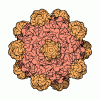+ Open data
Open data
- Basic information
Basic information
| Entry | Database: PDB / ID: 4qc8 | ||||||
|---|---|---|---|---|---|---|---|
| Title | Structural annotation of pathogenic bovine Parvovirus-1 | ||||||
 Components Components | VP2 | ||||||
 Keywords Keywords | VIRUS / parvovirus / capsid protein / beta barrel / VP2 / ssDNA virus / jellyroll / nucleoplasmin-like/VP / viral coat / coat protein | ||||||
| Function / homology |  Function and homology information Function and homology informationcalcium-independent phospholipase A2 activity / symbiont entry into host cell via permeabilization of host membrane / microtubule-dependent intracellular transport of viral material towards nucleus / phospholipase A2 / calcium-dependent phospholipase A2 activity / T=1 icosahedral viral capsid / lipid catabolic process / viral penetration into host nucleus / host cell / clathrin-dependent endocytosis of virus by host cell ...calcium-independent phospholipase A2 activity / symbiont entry into host cell via permeabilization of host membrane / microtubule-dependent intracellular transport of viral material towards nucleus / phospholipase A2 / calcium-dependent phospholipase A2 activity / T=1 icosahedral viral capsid / lipid catabolic process / viral penetration into host nucleus / host cell / clathrin-dependent endocytosis of virus by host cell / host cell cytoplasm / virion attachment to host cell / host cell nucleus / structural molecule activity / metal ion binding Similarity search - Function | ||||||
| Biological species |  Bovine parvovirus-1 Bovine parvovirus-1 | ||||||
| Method |  X-RAY DIFFRACTION / X-RAY DIFFRACTION /  SYNCHROTRON / SYNCHROTRON /  MOLECULAR REPLACEMENT / Resolution: 3.2 Å MOLECULAR REPLACEMENT / Resolution: 3.2 Å | ||||||
 Authors Authors | Kailasan, S. / Halder, S. / Gurda, B.L. / Bladek, H. / Chipman, P.R. / McKenna, R. / Brown, K. / Agbandje-McKenna, M. | ||||||
 Citation Citation |  Journal: J Virol / Year: 2015 Journal: J Virol / Year: 2015Title: Structure of an enteric pathogen, bovine parvovirus. Authors: Shweta Kailasan / Sujata Halder / Brittney Gurda / Heather Bladek / Paul R Chipman / Robert McKenna / Kevin Brown / Mavis Agbandje-McKenna /  Abstract: Bovine parvovirus (BPV), the causative agent of respiratory and gastrointestinal disease in cows, is the type member of the Bocaparvovirus genus of the Parvoviridae family. Toward efforts to obtain a ...Bovine parvovirus (BPV), the causative agent of respiratory and gastrointestinal disease in cows, is the type member of the Bocaparvovirus genus of the Parvoviridae family. Toward efforts to obtain a template for the development of vaccines and small-molecule inhibitors for this pathogen, the structure of the BPV capsid, assembled from the major capsid viral protein 2 (VP2), was determined using X-ray crystallography as well as cryo-electron microscopy and three-dimensional image reconstruction (cryo-reconstruction) to 3.2- and 8.8-Å resolutions, respectively. The VP2 region ordered in the crystal structure, from residues 39 to 536, conserves the parvoviral eight-stranded jellyroll motif and an αA helix. The BPV capsid displays common parvovirus features: a channel at and depressions surrounding the 5-fold axes and protrusions surrounding the 3-fold axes. However, rather than a depression centered at the 2-fold axes, a raised surface loop divides this feature in BPV. Additional observed density in the capsid interior in the cryo-reconstructed map, compared to the crystal structure, is interpreted as 10 additional N-terminal residues, residues 29 to 38, that radially extend the channel under the 5-fold axis, as observed for human bocavirus 1 (HBoV1). Surface loops of various lengths and conformations extend from the core jellyroll motif of VP2. These loops confer the unique surface topology of the BPV capsid, making it strikingly different from HBoV1 as well as the type members of other Parvovirinae genera for which structures have been determined. For the type members, regions structurally analogous to those decorating the BPV capsid surface serve as determinants of receptor recognition, tissue and host tropism, pathogenicity, and antigenicity. IMPORTANCE: Bovine parvovirus (BPV), identified in the 1960s in diarrheic calves, is the type member of the Bocaparvovirus genus of the nonenveloped, single-stranded DNA (ssDNA) Parvoviridae family. ...IMPORTANCE: Bovine parvovirus (BPV), identified in the 1960s in diarrheic calves, is the type member of the Bocaparvovirus genus of the nonenveloped, single-stranded DNA (ssDNA) Parvoviridae family. The recent isolation of human bocaparvoviruses from children with severe respiratory and gastrointestinal infections has generated interest in understanding the life cycle and pathogenesis of these emerging viruses. We have determined the high-resolution structure of the BPV capsid assembled from its predominant capsid protein VP2, known to be involved in a myriad of functions during host cell entry, pathogenesis, and antigenicity for other members of the Parvovirinae. Our results show the conservation of the core secondary structural elements and the location of the N-terminal residues for the known bocaparvovirus capsid structures. However, surface loops with high variability in sequence and conformation give BPV a unique capsid surface topology. Similar analogous regions in other Parvovirinae type members are important as determinants of receptor recognition, tissue and host tropism, pathogenicity, and antigenicity. | ||||||
| History |
|
- Structure visualization
Structure visualization
| Structure viewer | Molecule:  Molmil Molmil Jmol/JSmol Jmol/JSmol |
|---|
- Downloads & links
Downloads & links
- Download
Download
| PDBx/mmCIF format |  4qc8.cif.gz 4qc8.cif.gz | 114.9 KB | Display |  PDBx/mmCIF format PDBx/mmCIF format |
|---|---|---|---|---|
| PDB format |  pdb4qc8.ent.gz pdb4qc8.ent.gz | 88.9 KB | Display |  PDB format PDB format |
| PDBx/mmJSON format |  4qc8.json.gz 4qc8.json.gz | Tree view |  PDBx/mmJSON format PDBx/mmJSON format | |
| Others |  Other downloads Other downloads |
-Validation report
| Summary document |  4qc8_validation.pdf.gz 4qc8_validation.pdf.gz | 427.3 KB | Display |  wwPDB validaton report wwPDB validaton report |
|---|---|---|---|---|
| Full document |  4qc8_full_validation.pdf.gz 4qc8_full_validation.pdf.gz | 460.8 KB | Display | |
| Data in XML |  4qc8_validation.xml.gz 4qc8_validation.xml.gz | 24.3 KB | Display | |
| Data in CIF |  4qc8_validation.cif.gz 4qc8_validation.cif.gz | 32 KB | Display | |
| Arichive directory |  https://data.pdbj.org/pub/pdb/validation_reports/qc/4qc8 https://data.pdbj.org/pub/pdb/validation_reports/qc/4qc8 ftp://data.pdbj.org/pub/pdb/validation_reports/qc/4qc8 ftp://data.pdbj.org/pub/pdb/validation_reports/qc/4qc8 | HTTPS FTP |
-Related structure data
| Related structure data |  6168C  1s58S S: Starting model for refinement C: citing same article ( |
|---|---|
| Similar structure data |
- Links
Links
- Assembly
Assembly
| Deposited unit | 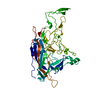
| |||||||||||||||||||||||||||||||||||||||||||||||||||||||||||||||||||||||||||||||||||||||||||||||||||||||||||||||||||
|---|---|---|---|---|---|---|---|---|---|---|---|---|---|---|---|---|---|---|---|---|---|---|---|---|---|---|---|---|---|---|---|---|---|---|---|---|---|---|---|---|---|---|---|---|---|---|---|---|---|---|---|---|---|---|---|---|---|---|---|---|---|---|---|---|---|---|---|---|---|---|---|---|---|---|---|---|---|---|---|---|---|---|---|---|---|---|---|---|---|---|---|---|---|---|---|---|---|---|---|---|---|---|---|---|---|---|---|---|---|---|---|---|---|---|---|---|
| 1 | x 60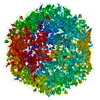
| |||||||||||||||||||||||||||||||||||||||||||||||||||||||||||||||||||||||||||||||||||||||||||||||||||||||||||||||||||
| 2 |
| |||||||||||||||||||||||||||||||||||||||||||||||||||||||||||||||||||||||||||||||||||||||||||||||||||||||||||||||||||
| 3 | x 5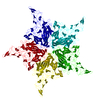
| |||||||||||||||||||||||||||||||||||||||||||||||||||||||||||||||||||||||||||||||||||||||||||||||||||||||||||||||||||
| 4 | x 6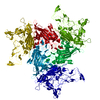
| |||||||||||||||||||||||||||||||||||||||||||||||||||||||||||||||||||||||||||||||||||||||||||||||||||||||||||||||||||
| 5 | 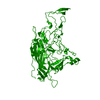
| |||||||||||||||||||||||||||||||||||||||||||||||||||||||||||||||||||||||||||||||||||||||||||||||||||||||||||||||||||
| 6 | x 30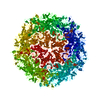
| |||||||||||||||||||||||||||||||||||||||||||||||||||||||||||||||||||||||||||||||||||||||||||||||||||||||||||||||||||
| Unit cell |
| |||||||||||||||||||||||||||||||||||||||||||||||||||||||||||||||||||||||||||||||||||||||||||||||||||||||||||||||||||
| Symmetry | Point symmetry: (Schoenflies symbol: I (icosahedral)) | |||||||||||||||||||||||||||||||||||||||||||||||||||||||||||||||||||||||||||||||||||||||||||||||||||||||||||||||||||
| Noncrystallographic symmetry (NCS) | NCS oper:
|
 Movie
Movie Controller
Controller



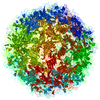
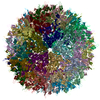
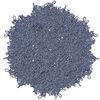
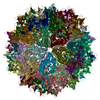
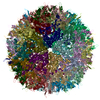

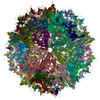

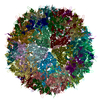
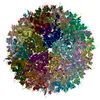
 PDBj
PDBj

